

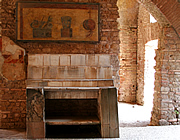
I had been wanting to visit Ostia Antica for a long time and finally made it in 2006. It exceeded all my expectations: a huge complex of living area stretching down to the once mighty harbour which served Imperial Rome.
Equally impressive is the Villa Adriana, Hadrian's vast palace east of Rome.
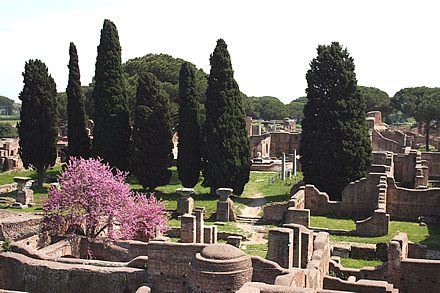
In all my reading on ancient Rome it is rare that Ostia Antica isn't mentioned. It was the major port for the city, connected to it by the Tiber, and therefore hugely important in an era when transport by ship was the standard method for long distances. I had long wanted to visit Ostia, even though I had no idea if there was anything to see - I felt sure there must be something left of such an important place. When we finally did make it here in 2006 I was absolutely blown away by the wealth of remains. This is where to come if you want to see a provincial Roman town, not as extensive as Pompeii but equally diverse in the types of building to be seen.
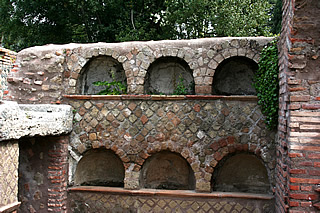
Founded in the fourth century BC it stands at the mouth (Ostium) of the Tiber. Originally it was important for its castle guarding the entrance to the river, and hence access to Rome. Its greatest period of prosperity was from the first to the third centuries AD but decline set in with political uncertainty. Later the harbour silted up, so it's not possible to see anything of the actual harbour works, but the taverns and houses, shops and public buildings speak of a once prosperous and bustling city.
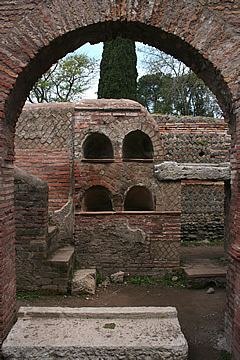 Columbarium in the necropolis.
Columbarium in the necropolis.
Before entering the city through the Porta Romana there is a very well-preserved necropolis on the Via Ostiense. As well as many tombs there are columbaria, with niches for urns. Roman dead were always interred outside city walls and tombs line major roads for many miles.
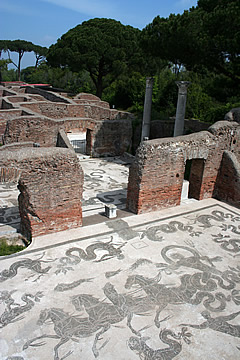
Ostia had a remarkable number of baths, the Baths of Neptune on of the most impressive, with magnificent black and white mosaic floors - the baths are named for the large mosaic of Neptune in a chariot drawn by hippocampi.
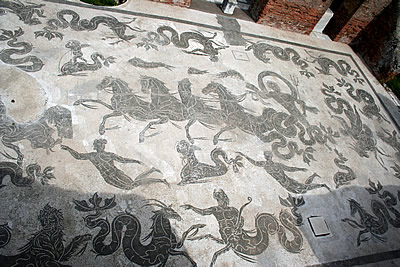
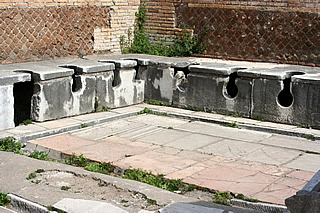
Of course Ostia, as a large and important city, had its Forums, a fine large theatre and temples, but herte I was more interested in the domestic buildings, the homes, shops and taverns. For instance, some of the best-preserved latrines of the Roman world can be found at Ostia! The photograph on the left shows public latrines for men - very sociable. It is said that the hole on the front face of the latrine was for inserting a washing sponge on a stick.
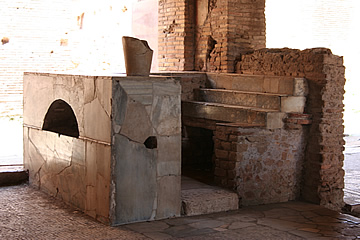
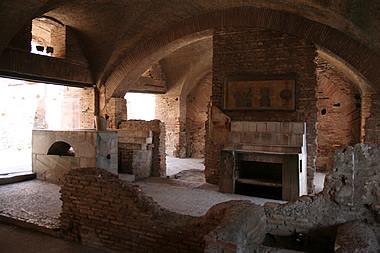
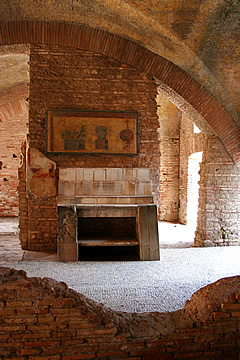
There is an abundance of intact shops and bars, one of the most remarkable of these is the Thermopolium of Via di Diana. It is so complete you almost feel you could order something from the bar.
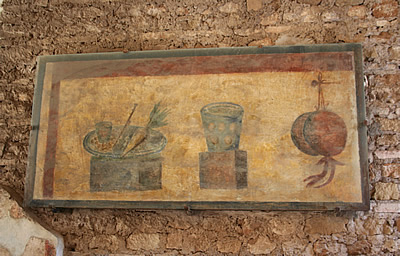
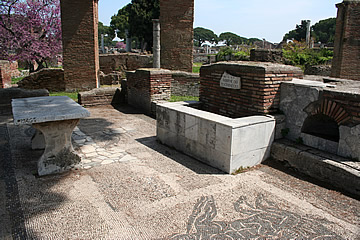 Taberna dei Pescivendolo - shop of the fishmonger.
Taberna dei Pescivendolo - shop of the fishmonger. 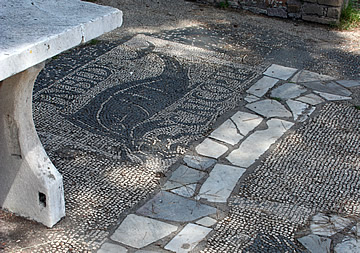
Some of the very well-preserved shops include a fishmongers on the Decumanus Maximus. The shop retains its marble table and dolphin and triton floor mosaics. It is very easy to imagine this shop busy on a normal day in Ostia, full of shoppers and the fishmonger cutting fish on the table.
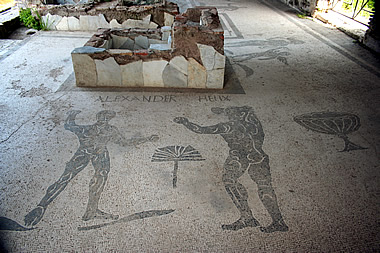
We walked as far as possible along the Decumanus Maximus which runs west for a while from the Porta Roman and then south west for a distance of almost 2km. At its furthest western end it would have led to the harbour area but this is now closed off. Here, right on the road, is a bar with a fine mosaic floor of two pancratiasts (boxers/wrestlers) - Alexander and Helix. There is also a mosaic of Diana with a mirror which suggests there might also have been a room for a brothel here.
The Ostia Antica website has a great deal of information, photographs, and sketches of reconstructions.
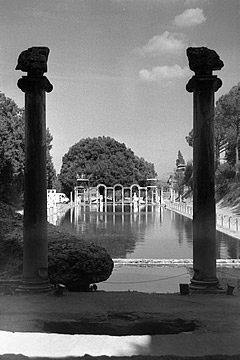
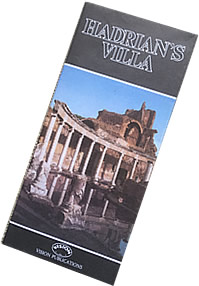
In 2001, while we were visiting the Abruzzo, we made a two hour drive to the immense Villa Adriana just outside Tivoli, about 40km north east of Rome. A very good plan and guide to the Villa helps to figure out what you are looking at!
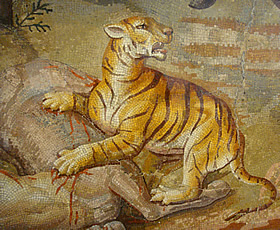
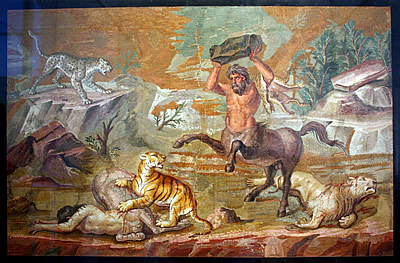
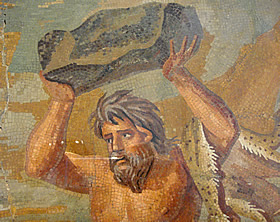
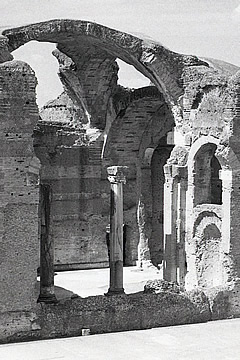
Completely deserted the day we visited - and incredibly hot as the morning wore on - the villa is an impressive collection of ruins which take some time to explore fully. It was built by the Emperor Hadrian as a retreat and for his retirement in 138AD and designed to include replicas of some of the buildings he had seen during his travels and which he most admired. It was completed in 133AD, five years before the Emperor's death
Laid out over 300 acres are the opulent palace, little of which is recognisable, temples, libraries, theatres, pools and baths, all adorned with colonnades, fine mosaics and statuary.
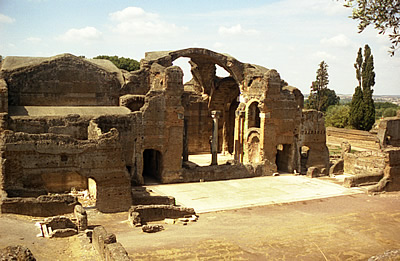
The Great Baths, for men, were massive, comprising a huge circular hall with sauna (deduced as such because it has no water supply), tepidarium, calidarium and a hall with three pools, frigidarium with two pools and a wide cross-vaulted room decorated with stuccoes.
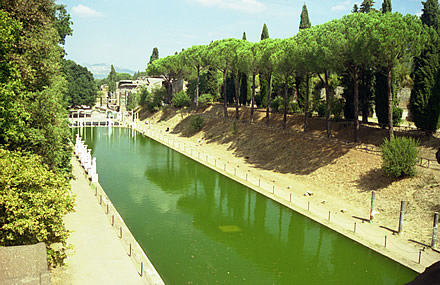
The tranquil Canopus is located in a long and narrow natural valley, the centre occupied by a long pool with, the north end curved. This end is by a colonnade of alternately arched and flat architraves, colonnades also run down the east and west sides of the pool. Caryatids replace the central columns on the west side, copies of those from the Erechtheum on Athens' Acropolis. There are other statues representing the Nile, Tiber, a crocodile. Statues of Ares, Hermes, Athena and two Amazons stood between the columns. On the south side is a large Nymphaeum, a Temple of Serapis, a copy of the Sanctuary of Serapis near Alexandria, Egypt.
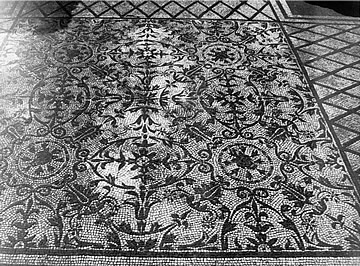
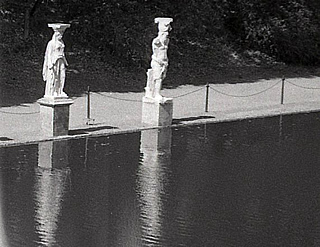
The mosaics were particularly intact and impressive in the Hospitalia, the sleeping quarters of the Pretorians.
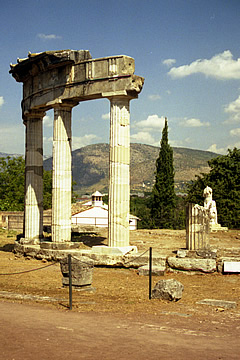
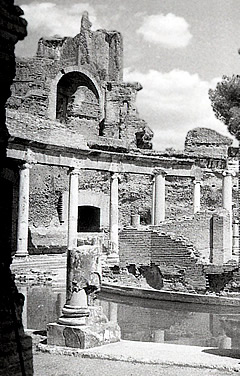
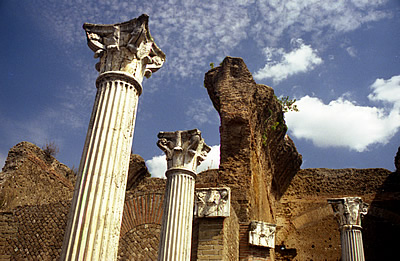
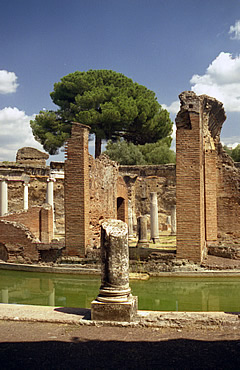
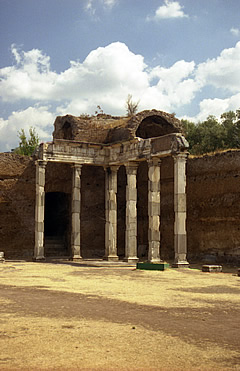
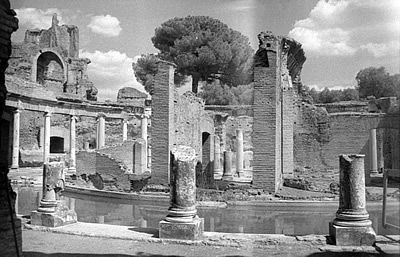
The Maritime Theatre is on a more human scale: a circular building with an Ionic portico enclosing a circular canal surrounding an island with a miniature villa. The villa has a curved vestibule, a peristyle with concave sides and a central fountain, a living room (tablinum) with adjoining rest rooms, a small set of baths complete with apodyterium, frigidarium, calidarium and latrine. This was a perfect secluded retreat for the Emperor, a place to study, for Hadrian wasan intellectual and learned man whi had created an efficient state burocracy and revised and simplified the legal and administrative system.
What strikes one most about the villa, apart from its massive extent, is the contrast between the huge public rooms and the intimate areas meant for Hadrian's private use, a glimpse into the nature of this famous emperor who spent increasing amounts of time here as he neared the end of his life.